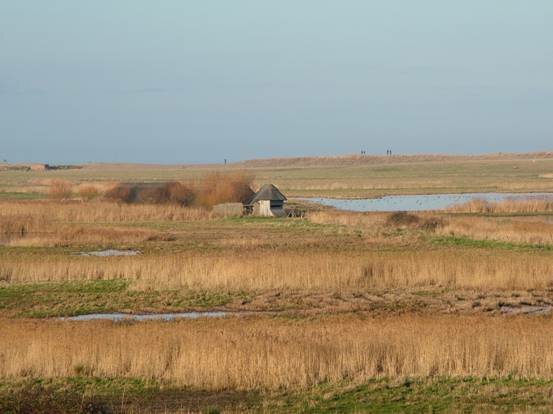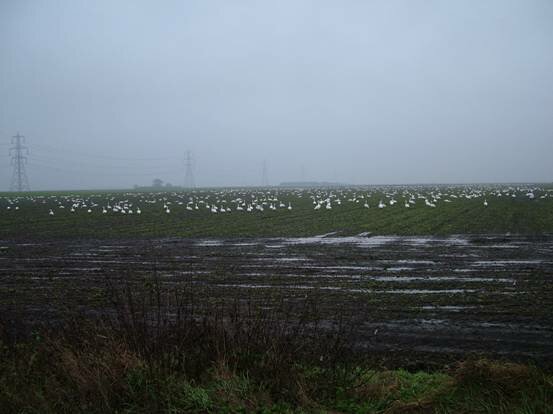?North Norfolk 2-3rd January 2006 by Martin Cracknell
At a loss what to buy me for Christmas my wife remembered that I had been interested in the idea of starting my 2006 bird list with a trip to North Norfolk. So she reserved us one night at the Briarfields Hotel in Titchwell and booked me on a walk at Titchwell Marsh RSPB the following morning that had the goal of seeing as many birds as possible in a couple of hours. So having dragged Janice and the two children out of bed reasonably early on 2nd January we set off to Norfolk, arriving in time for breakfast at Morrisons in Cromer (unfortunately we had forgotten that Norfolk is stuck in a timewarp and even major supermarkets only open when they feel like it and so it was shut). Disastrous start! However whilst turning round in the deserted car park I spotted 3 Waxwings feeding on a berry-laden tree in a corner of the car park, so maybe not such a bad start after all. Jackdaw, Starling, Blackbird and Pied Wagtail were added in the car park and onwards towards Sheringham we drove still hungry. A brief few minutes of seawatching, whilst the troops took a comfort break, from near the boating lake at the golf course end of the town produced scant reward, Black Headed Gull, Herring Gull, Common Gull and Great Black-backed Gull on the beach below and House Sparrow in the ornamental gardens were all that was seen. A quick brunch was taken in Holt before we headed back to the coast to take advantage of the glorious weather with clear blue skies and bright sunshine. The first of the remaining birders looking in vain for the Rosss Gull seen on 31/12 and 1/1 were encountered at Salthouse en masse. Dark-bellied Brent Goose, Greylag Goose, Canada Goose, Lapwing, Redshank, Curlew, Moorhen, Coot and Wigeon were seen on Salthouse Marsh and a very confiding flock of 20 Snow Bunting were present near the beach car park along with 12 Turnstone. A reported Shore Lark could not be found on the beach but distant views of a Tundra Bean Goose on the marsh almost made up for that. The birding masses were even more in evidence at Cley and following a quick recce from the vantage point of the visitor centre (closed for the winter) it was decided not to walk out to the obviously packed hides. Grey Heron, Mallard, Teal, Shoveler, Shelduck and Pintail were seen distantly on the pools from here along with Blue Tit, Great Tit, Dunnock, Greenfinch, Chaffinch and Goldfinch in the bushes on the slope up to the visitor centre. Finding a parking spot at Cley beach car park was a lot more testing than spotting the (presumably sick) Guillemot that was on the beach surrounded by about a dozen people taking photos. A pair of Gadwall were on the sea with a flock of c.100 Wigeon. 3 Red-throated Divers were present along with a Great Crested Grebe, 6 Goldeneye and a Lesser Black-backed Gull was on the beach. On to Holkham and Lady Ann Drive was busy too. The huge flock of Pink Footed Goose were very impressive (apparently c.50,000). A Goldcrest was calling as we walked through the pines, plenty of Meadow Pipit were around the dunes and the strandline. Red-necked Grebe was nice reasonably close in on the sea (unlike the sea which was typically miles away), good numbers of Common Scoter were a little further out but certainly 1000+ and a quick chat with a few other birders quickly dissuaded me from searching for the elusive flock of 6 Shore Lark. The light was beginning to fade as we walked back up Lady Ann Drive and I failed to pick out any Black Brant in the Dark-bellied Brent Goose flocks. Kestrel, Magpie, Carrion Crow, Woodpigeon, Collared Dove, Pheasant and Rook were all seen at various points along the coast road and a late treat came as we drove towards Titchwell in the gloom when a Barn Owl ghosted across the road in front of us. A pleasant evening was spent at Briarfields and I awoke the next morning ready for my booked walk at Titchwell Marsh. On the short walk to the reserve I saw two Egyptian Goose, Red-legged Partridge, Skylark and a Green Woodpecker. I was a little concerned that the walk was going to be a painful experience, trailing round the reserve with about 20 non-birders but was pleasantly surprised to find there were only 5 other birders and our guide. The weather was in total contrast to the previous day with low grey cloud, mist and incessant drizzle making our guide think that we would be very fortunate to make 60 species in the next couple of hours. As it was just past high tide we didnt delay and headed straight down to the beach, pausing only to take in a female Marsh Harrier quartering the saltmarsh. Once at the beach we were treated to excellent close views of c.2000 Common Scoter, close enough to easily pick out several Velvet Scoter amongst them. At least 10 Red-breasted Merganser were also on the sea, 3 Guillemot, 12+ Eider, Cormorant, Great Crested Grebe, Pochard and a lone Red-throated Diver (No other Divers or even Long-tailed Duck maybe 60 was optimistic!). A close and very smart looking Slavonian Grebe was the highlight of the seawatching. Attention was then switched to the wader roosts on the beach. Decent sized flocks of Bar-tailed Godwit and Oystercatcher were present as were lesser numbers of Grey Plover, Curlew, Turnstone, Dunlin, Knot, Sanderling, Ringed Plover and a solitary Purple Sandpiper. A bedraggled flock of Linnet were working the strandline. With the rain steadily becoming more persistent/heavier we abandoned the beach and began to make our way back. Little Egret and an over wintering Spotted Redshank were found on the saltwater lagoon. Shelter was sought in the Parrinder hide where a Red Breasted Merganser was fishing right outside the window on the brackish lagoon. Tufted Duck and Black-tailed Godwit were also seen on the brackish marsh along with several hundred Golden Plover. A Green Sandpiper was on the freshwater lagoon along with 8 Avocet (apparently its only very recently that any have wintered at Titchwell), Mute Swan, Snipe and a Reed Bunting in the reed bed by the path. Song Thrush, Long-tailed Tit, Robin, Great Spotted Woodpecker and Wren were all seen around the Meadow trail until a report of a Waxwing in the car park saw us scurrying out to search for it. No sign of it but we did manage to tick off Coal Tit and walking back to the visitor centre a small flock of Siskin were admired in the Alder. At this point with both us and our optics soaked we called it a day with the count for the couple of hours at 61. Not fantastic but considering the weather not too bad. It was decided to take a circuitous route back home and so we soon found ourselves rattling along the bumpy track along to Holme-next-the-sea NWT Reserve. The hoped-for Long-tailed Duck were not seen here either with a couple of Red-breasted Mergansers on the sea and two Red-throated Diver flying east all that was seen from the deserted beach. A couple of hundred Fieldfare were at large on the reserve with several Redwing amongst them and a Stonechat was along the main track as we departed. Next port of call was Welney WWT. Whilst on the way to Welney we came across a field that had been freshly harvested of its beet crop and c.1500 Whooper Swan and Bewick Swan were feeding on the discarded tops. A fantastic sight which the photo below does no justice to.
The weather had really closed in by now and disappointingly with visibility around 100yds there was no chance of seeing the American Wigeon that is currently in residence there and neither Smew nor Goosander were seen before the darkness closed in shortly before 4pm. The only other bird of note was a hybrid Pochard x Tufted Duck which was doing a reasonable impression of a Lesser Scaup. A very enjoyable couple of days in a lovely part of the world. 95 species seen which was below the 100 target that I had wanted to see, and certainly not a total that would be beyond a decent couple of days birding in South Essex but the weather on the second day did not help. Several obvious birds missed No Jay or Sparrowhawk for example and time plus the family in tow prevented me from taking advantage of any scarcer birds that were around locally e.g. Little Bunting and Dartford Warbler were at a site I know well near Stiffkey and a Bittern spent the two days we were there out in the middle of a field of cows at Kelling Water Meadows! All images on this page appear courtesy of and copyright to Martin Cracknell |
Page last updated:
Web Design Graham Mee. ? Copyright of all pages South East Essex RSPB Local Group. All images copyright of owners
The Royal Society for the Protection of Birds. Registered charity no 207076



